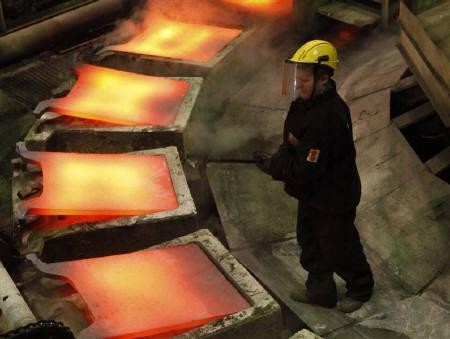New Kind of Memory Alloy Returns to Shape 10 Million Times
| Eana Maniebo | | Jun 03, 2015 10:45 AM EDT |
(Photo : REUTERS) A worker operates with fused non-ferrous metals at the copper plant of the Norilsk Nickel company in Russia's Arctic city of Norilsk. Our society uses many memory shape alloys for day-to-day applications, with a number of innovations constantly surfacing to keep up with the standards of living. Without nickel and copper, this achievement in the science and metals sector will not be possible.
Memory shape alloys, or a type of metal that "remembers its shape," is a valuable fusion metal used in aircraft, medical, and lifestyle-driven industries. Memory shape alloys are nicknamed "smart metals" because of their ability revert to their original shape when exposed to heat. Through a process called "phase transition," the metal returns to its original shape after being exposed to heat or after the release of tension.
Like Us on Facebook
Our society uses many memory shape alloys for day-to-day applications, with a number of innovations constantly surfacing to keep up with the standards of living. Common applications include eyewear, underwire clothing, aircraft components, and surgical operations, in the form of heart stents.
In 2013, a kind of memory shape alloy called "martensite" was developed at the University of Minnesota. Made from a mixture of nickel and titanium, martensite had two different arrangements of atoms that shift seamlessly. Martensite can return to its original shape for over 16,000 times without losing its quality.
A new development of this material is designed to withstand "high cycle fatigue" applications, meaning that it can come back to shape for 10 million times, a far leap from 16,000 returns. Made from nickel, titanium, and copper, the new development has broken previous memory shape alloy records, including the one set by martensite.
"Usually, shape memory alloys - like in minimally invasive surgery - they regain their shape once, or a few times, but not multiple times," said Prof Manfred Wuttig, one of the authors of the development's official documentation in Science Magazine.
Wuttig already thinks that this new kind of memory alloy is a "leap forward" because of the configurations that made its resilient characteristic. Wuttig developed the metal alloy with co-engineers at the University of Kiel in Germany, where they found out that nickel, titanium, and copper can be arranged in a certain way where they can switch between two configurations for virtually countless times.
Aside from the configurations, tiny particles of an impurity formed by titanium and copper (Ti2Cu) made the switching or re-shaping process swift and easy. Made in tiny 1 centimeter square pieces, this version of memory shape alloy was tested using heat and stress application.
Researchers and heads of developmental design are already interested in using this new memory shape alloy in several applications. Professor John Huber, a materials engineer at the University of Oxford, said that this new alloy has a lot of possible applications, including wing flaps or "control" surfaces of aircraft. Huber added that it can also be used for the unfolding of solar panels of a spacecraft. This new kind of alloy is so sturdy and resilient that it can be a main element of artificial heart valves because its durability can outlast the general expected life cycle of humans.
Without nickel and copper, this achievement in the science and metals sector will not be possible. This development is already on the rise, which means a steady supply of nickel and copper from mines will be needed to sustain it. Amur Minerals Corporation (AIM: AMC) is one company that stands as a likely candidate. The company was recently awarded its mining license for its Kun-Manie deposit.
Once the company starts selling its supply to various distributors around the world, medical and research institutions will have greater access to high-grade nickel and copper for the further research and development of smart metals.
Tagsmemory shape alloys, smart metal, University of Minnesota, martensite, process of making smartmetals, Amur Minerals, Kun-Manie, supply of smartmetals
©2015 Chinatopix All rights reserved. Do not reproduce without permission
EDITOR'S PICKS
-

Did the Trump administration just announce plans for a trade war with ‘hostile’ China and Russia?
-

US Senate passes Taiwan travel bill slammed by China
-

As Yan Sihong’s family grieves, here are other Chinese students who went missing abroad. Some have never been found
-

Beijing blasts Western critics who ‘smear China’ with the term sharp power
-

China Envoy Seeks to Defuse Tensions With U.S. as a Trade War Brews
-

Singapore's Deputy PM Provides Bitcoin Vote of Confidence Amid China's Blanket Bans
-

China warns investors over risks in overseas virtual currency trading
-

Chinese government most trustworthy: survey
-

Kashima Antlers On Course For Back-To-Back Titles
MOST POPULAR
LATEST NEWS
Zhou Yongkang: China's Former Security Chief Sentenced to Life in Prison

China's former Chief of the Ministry of Public Security, Zhou Yongkang, has been given a life sentence after he was found guilty of abusing his office, bribery and deliberately ... Full Article
TRENDING STORY

China Pork Prices Expected to Stabilize As The Supplies Recover

Elephone P9000 Smartphone is now on Sale on Amazon India

There's a Big Chance Cliffhangers Won't Still Be Resolved When Grey's Anatomy Season 13 Returns

Supreme Court Ruled on Samsung vs Apple Dispute for Patent Infringement

Microsoft Surface Pro 5 Rumors and Release Date: What is the Latest?










